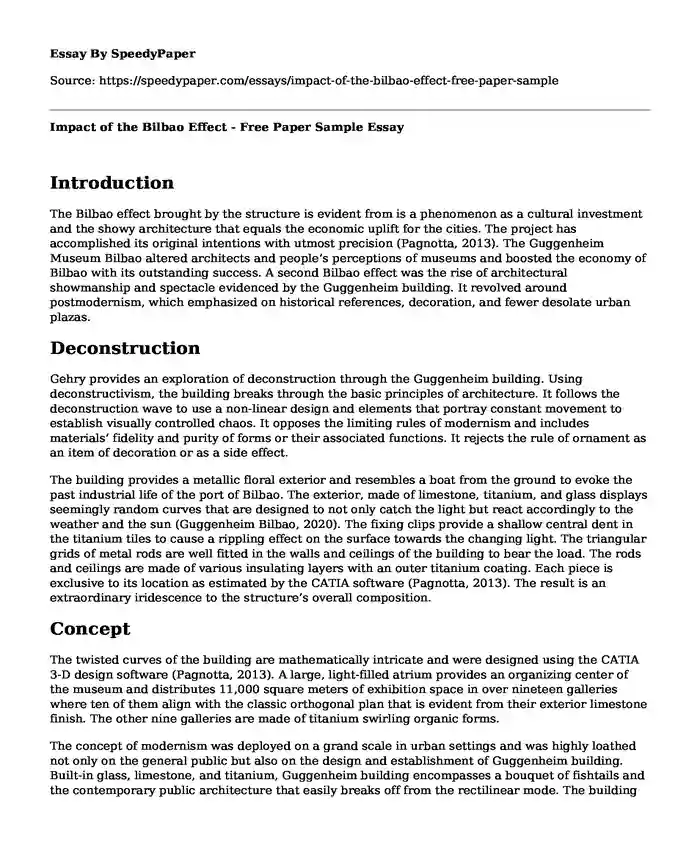
| Type of paper: | Essay |
| Categories: | Culture Economics Architecture |
| Pages: | 3 |
| Wordcount: | 594 words |
Introduction
The Bilbao effect brought by the structure is evident from is a phenomenon as a cultural investment and the showy architecture that equals the economic uplift for the cities. The project has accomplished its original intentions with utmost precision (Pagnotta, 2013). The Guggenheim Museum Bilbao altered architects and people’s perceptions of museums and boosted the economy of Bilbao with its outstanding success. A second Bilbao effect was the rise of architectural showmanship and spectacle evidenced by the Guggenheim building. It revolved around postmodernism, which emphasized on historical references, decoration, and fewer desolate urban plazas.
Deconstruction
Gehry provides an exploration of deconstruction through the Guggenheim building. Using deconstructivism, the building breaks through the basic principles of architecture. It follows the deconstruction wave to use a non-linear design and elements that portray constant movement to establish visually controlled chaos. It opposes the limiting rules of modernism and includes materials’ fidelity and purity of forms or their associated functions. It rejects the rule of ornament as an item of decoration or as a side effect.
The building provides a metallic floral exterior and resembles a boat from the ground to evoke the past industrial life of the port of Bilbao. The exterior, made of limestone, titanium, and glass displays seemingly random curves that are designed to not only catch the light but react accordingly to the weather and the sun (Guggenheim Bilbao, 2020). The fixing clips provide a shallow central dent in the titanium tiles to cause a rippling effect on the surface towards the changing light. The triangular grids of metal rods are well fitted in the walls and ceilings of the building to bear the load. The rods and ceilings are made of various insulating layers with an outer titanium coating. Each piece is exclusive to its location as estimated by the CATIA software (Pagnotta, 2013). The result is an extraordinary iridescence to the structure’s overall composition.
Concept
The twisted curves of the building are mathematically intricate and were designed using the CATIA 3-D design software (Pagnotta, 2013). A large, light-filled atrium provides an organizing center of the museum and distributes 11,000 square meters of exhibition space in over nineteen galleries where ten of them align with the classic orthogonal plan that is evident from their exterior limestone finish. The other nine galleries are made of titanium swirling organic forms.
The concept of modernism was deployed on a grand scale in urban settings and was highly loathed not only on the general public but also on the design and establishment of Guggenheim building. Built-in glass, limestone, and titanium, Guggenheim building encompasses a bouquet of fishtails and the contemporary public architecture that easily breaks off from the rectilinear mode. The building also looks back into the historical design and construction and pioneers in the application of digital technology and avant-garde materials in the architectural field. Its techno-morphic style implies relationships to the chronology of time, as it looks futuristic (Pagnotta, 2013). The reflective surfaces, due to the changes in natural light, convey the message of passing time.
Conclusion
Thus, the use of natural light provides a subtle, and natural message as it envelopes the titanium, making it paradoxical and less mechanized. The use of reflective surfaces represents Gehry’s concerns about maintaining the contextual history in architecture. Gehry’s Guggenheim Museum is a powerful representation of the time continuum that openly accepts and incorporates the past, fused into the present.
References
Guggenheim Bilbao (2020). A structure of titanium, glass and limestone. Guggenheim-bilbao.eus. https://www.guggenheim-bilbao.eus/en/the-building/the-construction
Pagnotta, B. (2013, September 01). AD Classics: The Guggenheim Museum Bilbao/Gehry Partners. Archdaily.com. https://www.archdaily.com/422470/ad-classics-the-guggenheim-museum-bilbao-frank-gehry.
Cite this page
Impact of the Bilbao Effect - Free Paper Sample. (2023, Nov 26). Retrieved from https://speedypaper.com/essays/impact-of-the-bilbao-effect-free-paper-sample
Request Removal
If you are the original author of this essay and no longer wish to have it published on the SpeedyPaper website, please click below to request its removal:
- Essay Sample on Multicultural Competence: FHSP Perspectives
- Russia Politics in Our Free-to-Download Essay Example
- Values and Cultural Diversity - Essay Sample
- Free Essay on the Shift from Thinking about Government to Governance
- Free Essay Example on Guanxi Concept
- The Theory of Evolution. The Egypt's Middle Kingdom. Essay Example.
- Essay Sample on Relationship Between Culture and Power
Popular categories




